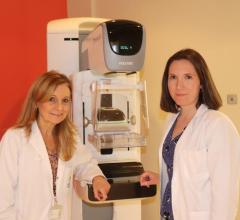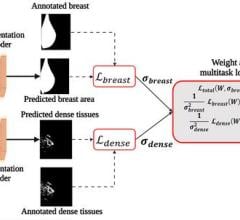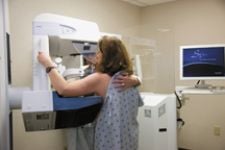
With the installation of the Hologic Selenia, the breast center shows its continuing
At the Yellowstone Breast Center of St. Vincent Healthcare in Billings, MT, the commitment to “total quality care” encompasses two key factors: providing state-of-the-art technology and state-of-the-art patient care.
The Breast Center fulfills this commitment in a variety of ways, from offering the latest in bone density and breast biopsy technology to providing same-day pathology results and surgical consults. With the installation of its Selenia digital mammography system in December 2007, it has stepped up to the challenge once again by becoming the first facility in eastern Montana to offer digital mammography.
“Both technology and patient services are part of the quality care we provide our patients,” said Pam Kaufman, the center’s QC Technologist. “Using the latest technology helps us provide the highest level of care, and that’s important to us.”
Transitioning to an All-Digital Environment
Though St. Vincent considers itself to be a technological leader in the healthcare industry, it did not take the decision to move to digital mammography lightly. According to Kaufman, the center began considering replacing its aging analog machines with digital equipment nearly two years ago, but opted to wait until the results of the Digital Mammographic Imaging Screening Trial (DMIST) trial were released before moving forward.
“Once the results came out demonstrating that digital is better at imaging dense breasts, we knew that digital would quickly become the standard of care,” Kaufman said. “We decided it was time to start fundraising.”
According to Kathleen Ryan, M.D., medical director of mammography at St. Vincent, transitioning from analog to digital was a “natural” choice because the center’s other imaging modalities had been digital for more than five years, and the radiologists were already accustomed to reading images from a screen.
“Clearly, digital technology is able to image denser breasts far better than film screen. As a radiologist, there is more confidence in interpreting those digital images,” explained Dr. Ryan when asked why offering digital mammography was so important to St. Vincent.
Although the employees had braced themselves for a difficult transition as they went from three analog to two digital machines, they were pleasantly surprised at how smoothly everything went. In fact, the technologists discovered that they could examine more patients with digital, despite the fact that they were working with one less machine. And best of all, they found that most patients felt that getting a mammogram with the new digital equipment was a lot more comfortable – even new patients said that their fear was unfounded and when their mammogram was over, it was not a big deal after all.
“I think we have the potential to move a lot more patients in and out, and move them a lot more smoothly,” said Pat Grimsley, supervisor of diagnostic imaging. And he notes that digital will also make it easier for St. Vincent to work with its sister facilities, which are located in remote areas of the state, by enabling them to transmit images electronically. “Digital is a plus for the patients, a plus for the technologists, with just a small learning curve for the radiologists,” he added.
Hologic All the Way
When Dr. Ryan, a Hologic customer for nearly 20 years, suggested going with the Selenia system, it didn’t take much to convince the rest of the staff.
“We considered systems from other manufacturers, but Hologic was the one company that gave us all the information we needed,” Kaufman said. “From supporting our technologists to answering any questions we had, Hologic bent over backwards to help us with the transition.”
The installation of the Selenia system was not the first time St. Vincent relied on Hologic for its technology needs. In fact, the move to digital mammography was one of the last in a series of technological upgrades St. Vincent has undertaken in the past year, all of which were supplied by Hologic. According to Kaufman, the center’s renovations started last year with the installation of the Hologic MultiCare Platinum stereotactic breast biopsy table. They also purchased Hologic’s Discovery advanced bone densitometry system and the Suros ATEC breast biopsy system before finally moving to digital mammography with the Selenia system and R2 digital CAD and a digitizer to convert their analog images to digital.
“There was really no question about going with Hologic,” Grimsley said. “We’ve always been happy with Hologic equipment. They have a great reputation.”
Compassionate Care
At the Yellowstone Breast Center, offering the latest imaging technology means nothing without combining it with compassionate patient care.
One way the center demonstrates compassion is its comprehensive approach to healthcare. St. Vincent Healthcare’s mission is to provide the whole continuum of care, not only offering mammography, but ultrasound, biopsies and surgery as well – and providing many of these services within the same day. “We’re not just here to screen patients, but to offer total quality care,” said Kaufman.
Comprehensive same-day services are particularly important because the center serves a largely rural population, with women traveling from as far as Wyoming to get a digital mammogram. “We serve a lot of women who come from out of town. For them, having same-day services is a huge plus because it eliminates the time and inconvenience of having to make multiple trips over long distances,” Kaufman noted.
When patients arrive at St. Vincent, they can also take comfort knowing that they won’t have to go through any procedure alone. The center employs a full-time nurse navigator who is dedicated to guiding women through the often confusing and overwhelming process that begins when an abnormality is identified during mammography.
Stephanie Streed, RNC, was not only the first nurse navigator at St. Vincent Healthcare, she was the first person to hold such a position in the entire state of Montana. The nurse navigator provides education and support to women, facilitating smooth navigation throughout all areas of breast health. Streed is there to schedule and attend surgical consults, where she takes notes and later reviews the information with the patient and their family. She also attends oncology and reconstructive surgery consults. On the day of surgery, Streed is available to attend the procedure and presents each woman with a gift bag and additional educational materials. Yet perhaps the most crucial part of her job is to provide emotional support for all newly diagnosed women.
“I’ve found that having a single point of contact makes it a lot easier for women,” Streed said. “They know they can call me anytime…in the office, at home at night, or on weekends. It’s a ‘no more sleepless nights’ philosophy. A nurse navigator is there to guide you every step of the way.”
Recognition for Excellence
St. Vincent Healthcare has worked hard to provide its patients the highest level of care, and its efforts have not gone unnoticed. The facility recently received its accreditation for the quality of its comprehensive cancer care from the American College of Surgeons Commission on Cancer, an honor bestowed upon less than 25 percent of healthcare facilities nationwide. To receive this recognition, centers are evaluated for compliance in nine different areas, including patient care, emphasis on prevention and early detection and cancer-related improvements. Not only did St. Vincent receive the honor of accreditation but it received commendation in all nine areas – the highest rating possible.
While thrilling, this recognition comes as no surprise to many of St. Vincent Healthcare employees.
“I’ve worked in many breast centers,” Streed said. “Yellowstone Breast Center is by far the most innovative, the most talented and the most compassionate.”

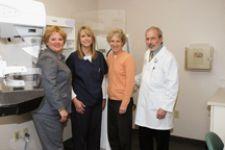
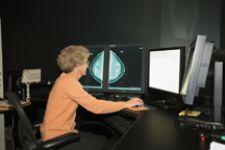

 April 02, 2024
April 02, 2024 
